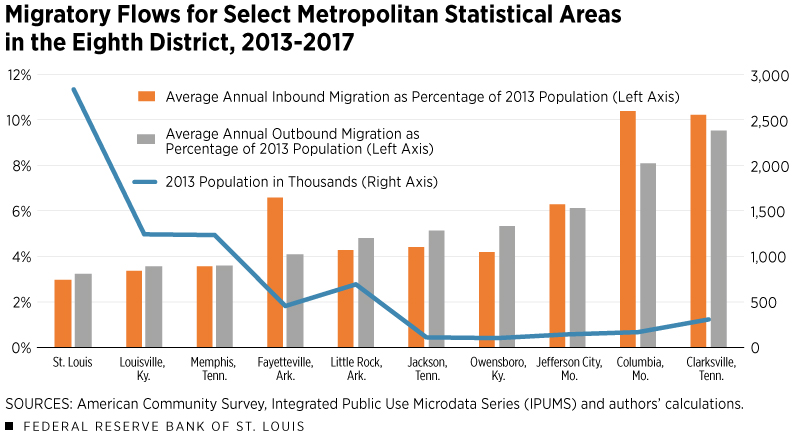Moving In (and Out) of the Eighth Federal Reserve District

The U.S. population growth rate has been declining in recent years, growing only 0.62% between 2017 and 2018. That was the lowest growth rate in 80 years. This is important for economic growth, because an increase in population means:
- More workers in the labor market
- More potential customers for products and services
- A healthy age structure between workers and retirees, which is important for a sustainable public pension system
Besides the natural birth and death rates, migration also plays an important role in population growth. In a recent Regional Economist article, Economist Sungki Hong and former Senior Research Associate Hannah G. Shell looked at migration in and out of the Eighth Federal Reserve District.The Eighth District includes the entire state of Arkansas, as well as parts of Illinois, Indiana, Kentucky, Mississippi, Missouri and Tennessee. While the District encompasses parts of these states, the authors looked at state-level data for all seven states. They also looked at some metro areas within the District. They also examined the demographics and socioeconomic characteristics of individuals moving into and out of the District.
To evaluate migration patterns, Hong and Shell used data calculated from the American Community Survey (ACS) five-year sampleThe authors noted that the five-year ACS data are a 5% sample of the U.S. population, covering more individuals than the ACS’s typical annual 1% sample. Microdata for the ACS are accessed from the Integrated Public Use Microdata Series (IPUMS). released in 2019—which covers 2013-2017—and they defined migration as movement to a different home within a state, between states or from abroad.
Which Metro Areas in the District Benefited Most from Net Migration?
The authors found that the overall size of the Eighth District’s population did not change much due to migration between 2013 and 2017, but some metro areas benefited more than others.
The figure below shows migration patterns for 10 metropolitan statistical areas in the District, with total population size in 2013 shown on the right and the average annual migration rate in and out of the metro areas between 2013 and 2017 on the left.

Hong and Shell made the following observations:
- The Clarksville, Tenn., metro area experienced the highest turnover rate between 2013 and 2017. Relative to its 2013 population, 10.2% moved into the area annually on average, while 9.5% moved out.The authors used the annual 1% ACS for 2013 from IPUMS to calculate 2013 population data at the metropolitan statistical area level. They noted that it is likely that Clarksville’s high migration rates as a percentage of its total population are due to its small size and proximity to a military base (Fort Campbell). They also pointed out that similarly high rates are also found in college towns: Columbia is home to the University of Missouri, and Fayetteville is home to the University of Arkansas.
- The St. Louis metro area saw the smallest turnover in population, with 3.0% moving in and 3.2% moving out each year on average.
- Both the Fayetteville, Ark., and the Columbia, Mo., metro areas benefited the most from the net influx from migrations. The average annual net increase from migration was equal to 2.5% and 2.3% of the 2013 population, respectively, in those metro areas.
- For the rest of the metro areas studied, they found that the inflows and outflows were roughly the same.
Who’s Moving In and Out of the Eighth District?
While looking at state-level data, Hong and Shell found that net migration into the District was positive, although it accounted for a very small fraction of the total population. As seen in the table below, they also evaluated migration flows by the following characteristics:
- Age: “One important aspect to consider is age,” they wrote. “The age structure affects the economy through the channel of labor supply and consumption-saving decisions.” They found that the 35-to-64-year-old age group had the largest annual migration average into and out of the District, while the 65-plus group had the smallest.
- Education attainment: The authors also looked at the education of those moving in and out of the District. People without any college education made up 52.9% of the population moving in, but made up only 50.6% of the population that was moving out, they showed.
- Income levels: “Those moving out of the District also earned a slightly higher income than those moving into the District,” they said, explaining that the median annual income of people moving in was $36,197, while the median income of people moving out of the District was $37,880.
|
|
|||
|
People Moving into District |
People Moving out of District |
Net Migration |
|
|
Age |
|||
|
Younger than 16 |
148,405 |
137,792 |
10,613 |
|
16-24 |
208,374 |
182,631 |
25,743 |
|
25-34 |
210,722 |
187,211 |
23,511 |
|
35-64 |
240,898 |
221,579 |
19,319 |
|
65+ |
59,052 |
57,051 |
2,001 |
|
Education |
|||
|
High School or Less |
459,023 |
397,981 |
61,042 |
|
Some College |
153,948 |
147,360 |
6,588 |
|
College Plus |
254,480 |
240,923 |
13,557 |
|
Median Wage and Salary Income |
$36,197 |
$37,880 |
|
|
SOURCES: American Community Survey, Integrated Public Use Microdata Series (IPUMS) and authors' calculations. |
|||
Notes and References
1 The Eighth District includes the entire state of Arkansas, as well as parts of Illinois, Indiana, Kentucky, Mississippi, Missouri and Tennessee. While the District encompasses parts of these states, the authors looked at state-level data for all seven states. They also looked at some metro areas within the District.
2 The authors noted that the five-year ACS data are a 5% sample of the U.S. population, covering more individuals than the ACS’s typical annual 1% sample. Microdata for the ACS are accessed from the Integrated Public Use Microdata Series (IPUMS).
3 The authors used the annual 1% ACS for 2013 from IPUMS to calculate 2013 population data at the metropolitan statistical area level. They noted that it is likely that Clarksville’s high migration rates as a percentage of its total population are due to its small size and proximity to a military base (Fort Campbell). They also pointed out that similarly high rates are also found in college towns: Columbia is home to the University of Missouri, and Fayetteville is home to the University of Arkansas.
Additional Resources
- Regional Economist: Moving In, Moving Out: The Migration Pattern of the Eighth District
- On the Economy: Domestic Migration Is Driving Population Growth in U.S. Cities
- Economic Synopses: Why Is the St. Louis Metro Area Population Growing So Slowly?
Citation
ldquoMoving In (and Out) of the Eighth Federal Reserve District,rdquo St. Louis Fed On the Economy, Dec. 3, 2019.
This blog offers commentary, analysis and data from our economists and experts. Views expressed are not necessarily those of the St. Louis Fed or Federal Reserve System.
Email Us
All other blog-related questions

